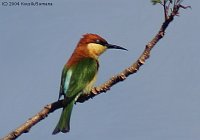Chestnut-headed Bee-eater (Merops leschenaulti) - Wiki Chestnut-headed Bee-eater
From Wikipedia, the free encyclopedia
[Photo] Chestnut-headed Bee-eater (Merops leschenaulti) in South India. Photography of Kousik Nandy and Sumana Paul. Date November 2004. Author Kousik Nandy
The Chestnut-headed Bee-eater, Merops leschenaulti is a near passerine bird in the bee-eater family Meropidae. It is a resident breeder in southern Asia from India east to southeast Asia and Indonesia.
This species, like other bee-eaters, is a richly coloured, slender bird. It is predominantly green, with blue on the rump and lower belly. Its face and throat are yellow with a black eye stripe, and the crown and nape are rich chestnut. The thin curved bill is black. Sexes are alike, but young birds are duller.
This species is 18???20 cm long; it lacks the two elongated central tail feathers possessed by most of its relatives.
This is a bird which breeds in sub-tropical open woodland, often near water. It is most common in highland areas. As the name suggests, bee-eaters predominantly eat insects, especially bees, wasps and hornets, which are caught in the air by sorties from an open perch.
These bee-eaters are gregarious, nesting colonially in sandy banks. They make a relatively long tunnel in which the 5 to 6 spherical white eggs are laid. Both the male and the female take care of the eggs. These birds also feed and roost communally. The call is similar to that of the European Bee-eater.
Its scientific name commemorates the French botanist Jean Baptiste Leschenault de la Tour.
http://en.wikipedia.org/wiki/Chestnut-headed_Bee-eater
| The text in this page is based on the copyrighted Wikipedia article shown in above URL. It is used under the GNU Free Documentation License. You may redistribute it, verbatim or modified, providing that you comply with the terms of the GFDL. |
